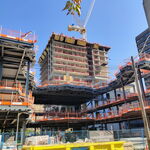SaugeenJunction
Senior Member
Could be interesting- would there be overlap between GO and VIA service?
Or could GO act as the local, slower system (serving Guelph, Waterloo, etc.) while VIA serves as the express (direct to Waterloo and beyond)? Lots of opportunities there, which probably makes the lack of progress all the more painful.
When I was in Switzerland this summer, I was impressed at how so many trains coupled/uncoupled at various stations, allowing for multiple “train trips” in one train schedule slot.
Imagine a VIA HFR train leaving Windsor or London on dedicated tracks, arriving at Kitchener, and coupling to the back of a Union-bound Express GO train. Two different trains, two different services, one time slot.
I understand this requires master timing, something that Switzerland has perfected, and that this scenario relies on no delays from CN for VIA (thus the dedicated tracks). One can only dream...







